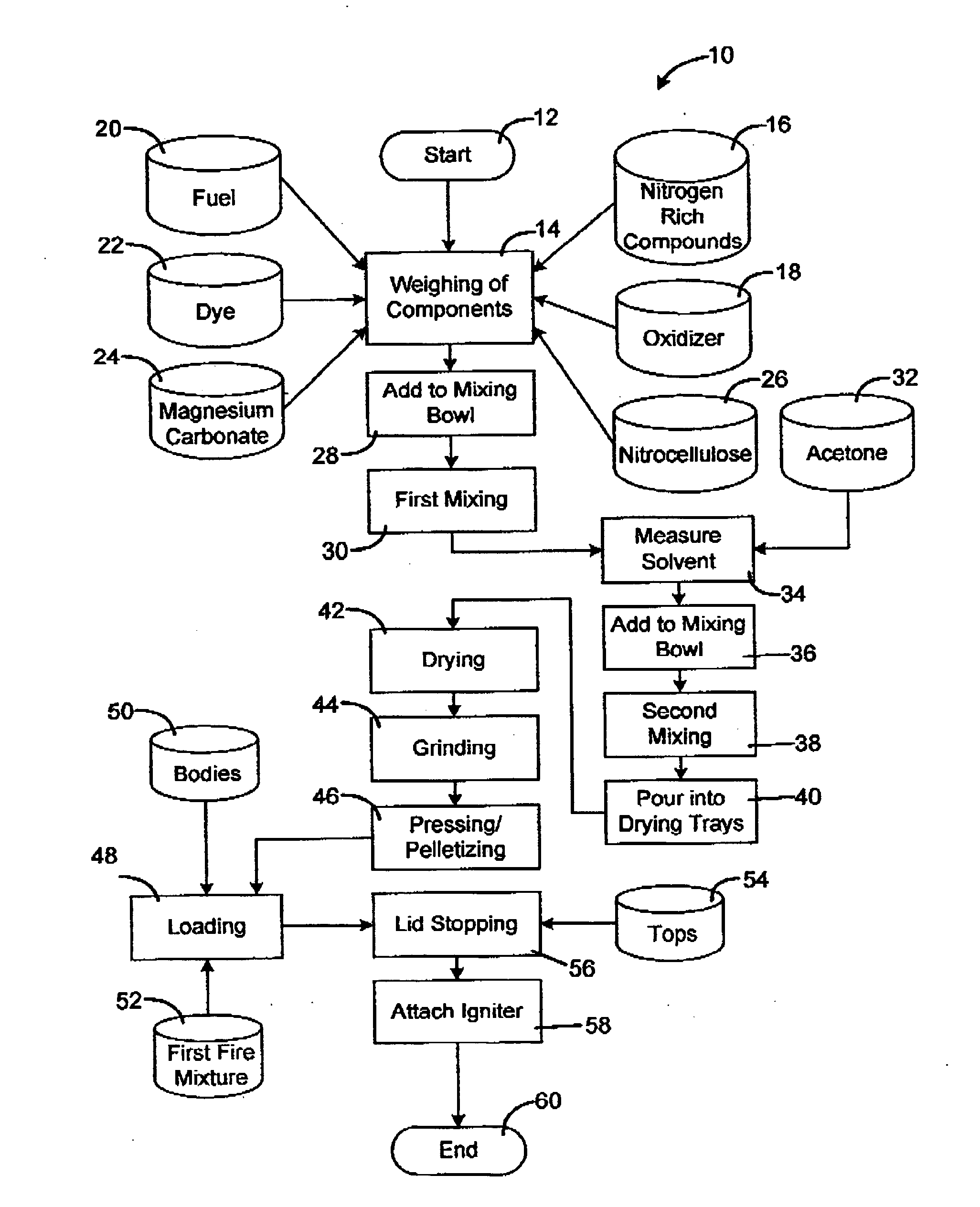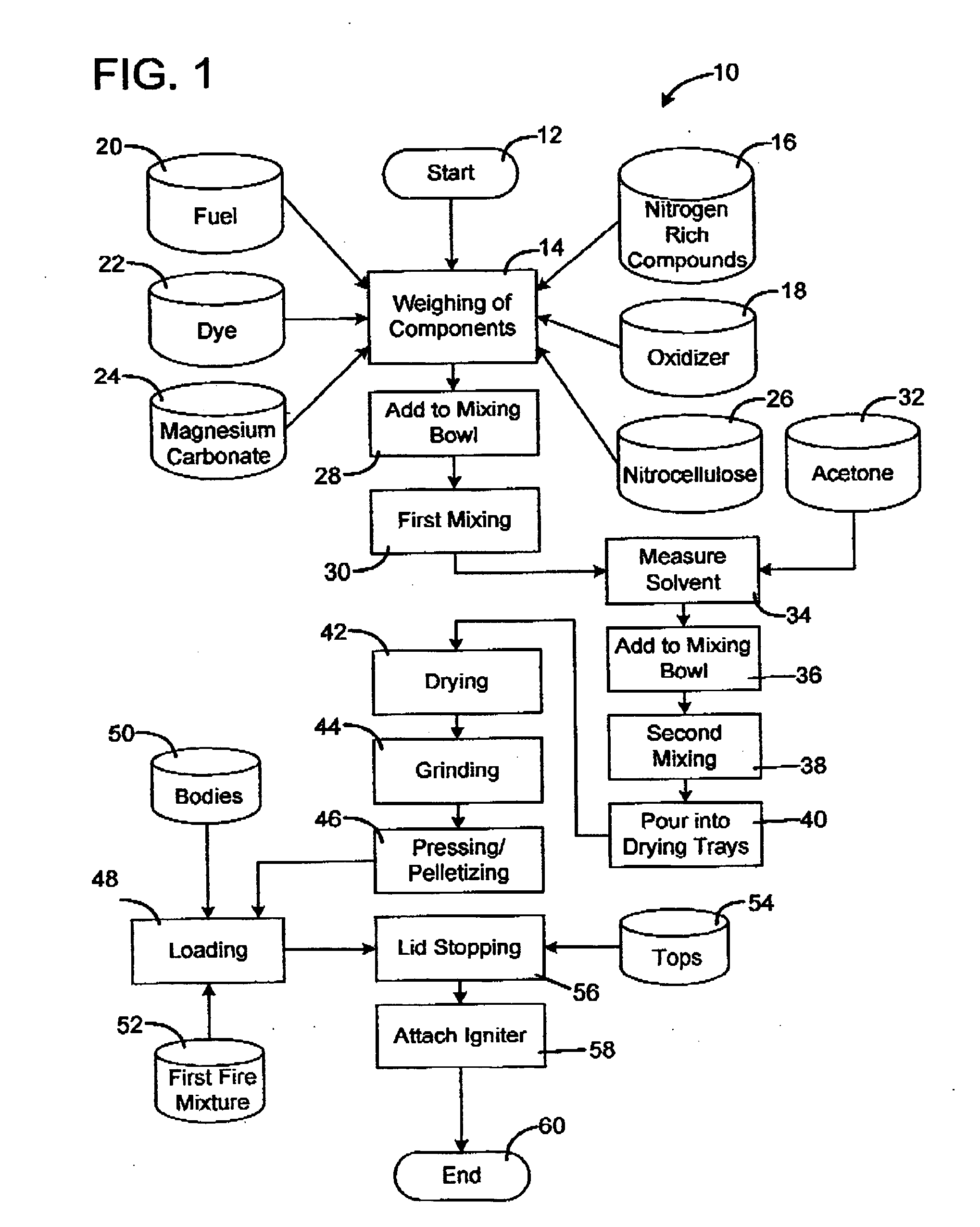If the temperature is too high, the dye molecules will decompose, and the generated smoke's
color quality and volume will deteriorate.
By considering the
kinetics of
combustion and the desired yield of
colored smoke, conventional smoke-producing compositions require a strongly exothermic composition, but struggle to limit the degradation of the coloring medium by
combustion.
A weakly exothermic composition is unsuitable because it permits only a minimal percentage of coloring medium and furnishes only a very mediocre smoke yield that is hardly visible, especially when there is a cloudy or dark
sky.
A weakly exothermic composition also is difficult to ignite to initiate
smoke emission.
However, most existing smoke-producing compositions have severe limitations.
One of the limitations is that of
toxicity.
Many smoke-producing compositions incorporate materials that are severely toxic or become irritants when subjected to the heat necessary to produce smoke.
Salts do not work well: ionic species generally have low volatility because of their strong inter-ionic attractions within the crystalline lattice.
At the typical reaction temperatures of smoke compositions, these groups are likely to release their
oxygen, leading to oxidative
decomposition of the dye molecules.
Groups such as —NH2 and —NHR (amines) are used, but potentially dangerous oxidative
coupling reactions can occur in an
oxygen rich environment.Old-style dyes for military markers and grenades are polycyclic or aromatic amino, hydroxyl, azo and keto compounds, in which unsaturation conjugated with the aromatic structure.
Such compounds are known to cause
chromosome mutations, which may lead to
cancer.
However, if the temperature of the fuel-oxidizer reaction is too high, the dye will degrade, and the quantity and
color quality of smoke generated will be unsatisfactory.
Although heat is required for the dye to undergo the essential phase changes to produce colored smoke, individual molecules of the dye are subject to degradation at elevated temperatures.
If the molecular structure of the dye is subject to forces and energies that are great enough to cleave the molecule's bonds, changes in smoke color or loss of color properties are likely to occur.
Another problem encountered in the search for a desirable smoke-generating composition is the production of a
solid residue as conventional smoke-producing compositions burn.
As a result,
deflagration can occur, which can
cause injury to bystanders, or result in only a limited release of colored smoke.
Furthermore, the formation of
slag increases the
decomposition of the dye vapor, which may lead to color deterioration.
Only a few dye materials have been found suitable for use in prior art smoke-producing compositions that rely upon the
vaporization of an
organic dye because most dye materials generate excessive
slag or clinkers.
Other known compositions have the drawback of burning at temperatures that are too high (600-800° C.) or leave too many carbonaceous residues, which are impermeable to the dye molecules in the
gas phase.
These conditions cause the destruction of the smoke-producing components and therefore demonstrate poor effectiveness in producing colored smokes.
Another drawback may be the rapid ascent of the smoke because of the smoke's high temperature, which causes the smoke to dissipate too quickly for the desired effect to be achieved.
Another major drawback of using such mixtures is the
hazard created by the creation of a flame front at the moment of ignition of the main filling composition.
This behavior can create safety hazards to personnel and equipment, as well as potentially causing
brush and grass fires in dry environments with significantly elevated fire danger conditions.
However, many smoke-producing compositions presently used are difficult to
handle.
Many such compositions are toxic and irritating, requiring special precautions during use.
Finally, some compositions produce an excess of heat and flame, again limiting their usefulness and requiring that additional safety measures be taken.
For these reasons, conventional smoke-producing compositions are found to be inadequate
 Login to View More
Login to View More  Login to View More
Login to View More 

